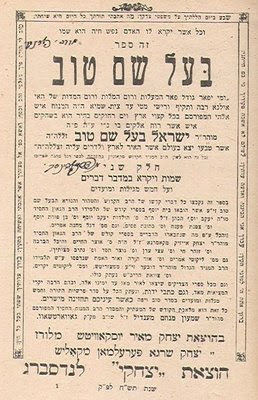Learning Toldos Yaakov Yosef - Step 1
When I asked my friend Nochum, who has learned Toldos Yaakov Yosef for many years, how he approached learning this extremely difficult sefer, he responded:
"My advice if you want to enter the world of the Toldos is to learn a lot of Sefer Baal Shem Tov al Hatorah, and go back and forth using his extensive footnotes. After a few years of that Toldos will become more understandable."
Similarly, A Yid also noted that he found Sefer Baal Shem Tov to be very useful and remarked,
"When learning it one has try to refer to sources, because it often takes quotes out of context leaving the reader to research the rest himself."
Starting last week, I have incorporated learning Sefer Baal Shem Tov, along with these useful English translations, into my weekly learning seder. As I wrote recently,
"If a musician finds that he is inspired by another musician he would be wise to determine who that musician's musical influences were and to listen to them as well. "










12 Comments:
I don't know if you have seen the new edition of the Toldos. The publisher is Nachlas Tzvi. It is reprinted with footnotes, cross references, etc... It has come out volume by volume so you can't yet buy a set. I also think it is not so easy to get. I just picked up Bamidbar in New York at Biegeleisens. I imagine they still have. Devarim is the only chelek not yet out. It is definitely not a sefer you can fly through. I look through it every now and then but have not extensively learned it.
A related topic:
The Sefer Baal Shem Tov is also filled with teachings from the Komarna Rebbe. I've found it a good way to begin to begin a study of the Komarna's work as well, since it tends to bring his more accessible teachings.
Another resource for this is the commentary Be'er Eliyahu (by R. Eliyahu Ovadiah on the Komarna's peirush of Megillat Esther, called Ketem Ofir. It's mind-blowing, as he really opens up the rich and otherwise inaccessible teachings of the Komarna. Prepare to enter the deep waters.
The Sefer Baal Shem Tov is by Rabbi Shimon Menachem Mendel Shub, published in
Lodz, Poland in 1938. Does anyone know what happened to him?
I've searched the internet data bases of records of Shoah victims but did not find his name.
Speaking of Sefer Baal Shem Tov: If you ever get into learning it I'd also strongly recommend the Peirush of the Bilvavi Mishkan Evneh on it--it's kind of the next level up in understanding the Besht.
The Bilvavi brings out deep insights from inside the Besht's teachings that I haven't seen elsewhere but that are undeniably intended in the teachings. He's into consciousness and the concepts of ayin and mesirut in a way that is very applicable to daily avodah.
I want to thank ASJ and Dixie Yid for getting me into the Bilvavi last year.
Jonathan,
Thanks for the recommendation. I haven't seen the sefer Habaal shem tov or Bilvavi's peirush inside yet. But I appreciate the information about it. And B"H if ASJ and I were able to be the kli to bring this amazing sefer to just one more Jew.
Gut Shabbos!
-Dixie Yid
Another great edition of Sifrey Toldoys was published by Reb Avrohom Loyfer (Laufer). Unfortunately he practically dropped his project without finishing the whole set (though he claimed he'll finish it some time).
Jonathan: Komarno is the world into itself.
Bahaltener:
Can you direct to me your favorite Komorno teachings?
Jonathan: There is a notable seyfer - Megilas Sesorim, where the Komarner Rebbe ztz"l recorded his dreams. Very interesting.
In one of them notably he spoke with G-d, in feminine representation (Schino) who appeared to him as a beautiful woman (though he didn't see her face, otherwise he could die).
This is just to note, that in our relations, we psychologically are trying to attribute to Bashefer some gender-like features, and mostly Hashem is related as He, however one must bear in mind that Bashefer is above all that, and in revealing into the world can have both musculine (Z"o) and femenine (Nukvo) qualities.
Thanks--I love that sefer too. I have it and I also have Heichal Habrachah/Otzar Hachaim, and Zohar Chai sets. Awesome material but much of it out of my depth. Still, I look for parts I can grasp.
Do you know of anyone who is teaching Komarna material today (other than R. Eliyahu Ovadiah?). I find a contemporary peirush really helps me with the material.
Does anyone know where I can acquire this sefer (in english)? I've searched everywhere online to no avail.
does anyone know if there is an english translation anywhere? is the edition via nachlas tzvi available for purchase online?
Post a Comment
<< Home